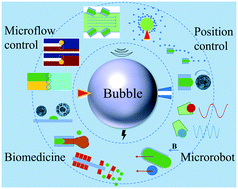Bubbles in microfluidics: an all-purpose tool for micromanipulation
Abstract
In recent decades, the integration of microfluidic devices and multiple actuation technologies at the microscale has greatly contributed to the progress of related fields. In particular, microbubbles are playing an increasingly important role in microfluidics because of their unique characteristics that lead to specific responses to different energy sources and gas–liquid interactions. Many effective and functional bubble-based micromanipulation strategies have been developed and improved, enabling various non-invasive, selective, and precise operations at the microscale. This review begins with a brief introduction of the morphological characteristics and formation of microbubbles. The theoretical foundations and working mechanisms of typical micromanipulations based on acoustic, thermodynamic, and chemical microbubbles in fluids are described. We critically review the extensive applications and the frontline advances of bubbles in microfluidics, including microflow patterns, position and orientation control, biomedical applications, and development of bubble-based microrobots. We lastly present an outlook to provide directions for the design and application of microbubble-based micromanipulation tools and attract the attention of relevant researchers to the enormous potential of microbubbles in microfluidics.

- This article is part of the themed collection: Lab on a Chip HOT Articles 2021


 Please wait while we load your content...
Please wait while we load your content...